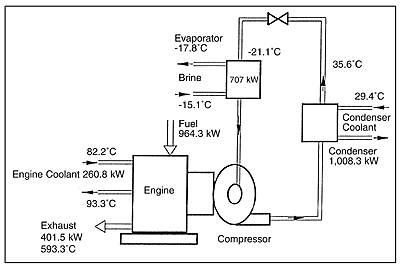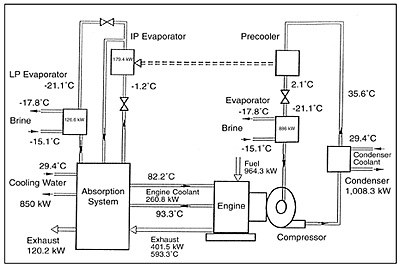
The company is not your typical manufacturer. Specializing in heat-activated absorption technology, Energy Concepts has been around for over 20 years, primarily doing research and development work for the government and some for private industry. President Don Erickson says that when a development is successful, the company will carry it through the field demonstration stage. “We don’t envision ourselves as major manufacturers,” says Erickson. “We are kind of the manufacturer of last resort – we’re basically R&D people.”
Erickson says the company’s main interest in improving industrial refrigeration systems is to reduce global energy consumption and global emissions. “We’d like to be good stewards of the planet. We’re interested in this type of technology, because [refrigeration] doesn’t get the development attention it deserves.”

How It Works
The new absorption-augmented system has actually been in the works for about four years. The system is based on another development called the GAX (generator absorber heat exchange) cycle. These heat-activated absorption cycles excel at using low-temperature waste heat and turning it into refrigeration or air conditioning.In the absorption-augmented refrigeration system, the prime mover is a gas-fired engine. Gas-fired engines are quite efficient at using high-temperature heat; however, they leave a lot of their energy – approximately 65% or 70% — behind as low-temperature waste heat, which is ideal for absorption. The total system combines an internal combustion engine with a mechanical compression refrigeration system powered by the engine shaft power and the waste-heat driven absorption refrigeration system.
Erickson says they’ve made the cycle more efficient by incorporating some internal heat recuperation within the absorption cycle.
“We’re bringing the cost down by applying advanced heat and mass transfer technology to the heat and mass exchanges inside the cycle. This is the most efficient and cost-effective thing you can do with low-temperature waste heat. Say around 600˚F or below, we can do at least half again more benefit at lower cost than just about any other technology out there.”
The company faced some technical challenges when designing the system. Specifically, this particular ammonia-water absorption system has an extreme resistance to heat and mass transfer if conventional heat exchangers are used. So, the company had to develop new, patented techniques for heat and mass exchange to boost performance while keeping the cost down.
And, of course, there are always those who resist using ammonia, due to concerns over increased safety regulations and potential problems. However, this system contains a relatively low 200 to 300 lbs of ammonia, so the concern isn’t as great as for those facilities with high inventories of ammonia.
Energy Concepts estimates that the new system will cut fuel consumption by 30%, and that by the year 2010, the new system could cut total fuel consumption by 19 trillion Btu and greenhouse gas emissions by more than 1 million tons per year.

Higher Costs Offset By Savings
As with any new technology, there may be a cost premium involved, depending on the application. Erickson notes that the lower you go in temperature, the more cost competitive the new technology becomes. At very deep levels of refrigeration, say –40˚F for blast freezing, the cost of the new technology is on par with electric compression refrigeration. The technology suffers a cost premium, however, as the temperature moves up.“We find as long as you’re looking at average electric rates or above average electric rates, we can still supply about a two-year payback for that cost premium,” says Erickson. “And, of course, the operating cost is essentially zero for our technology, versus high cost for the conventional technology.”
Even if companies aren’t interested in being “good stewards of the planet,” the calculations show the system will be a big money saver. In fact, Erickson says they were surprised at just how much more refrigeration can be achieved at a much lower cost. “There have been previous attempts to do what we’re doing using engine waste heat to run absorption systems, and typically people have gotten maybe 15% more benefit. What we found is that they just weren’t doing it right. We were pleased to see that as much as 40% could be achieved, because that’s what gets people’s attention.”
In addition, the new system is easy to maintain because it doesn’t have a compressor, which is usually the single largest maintenance component of the industrial refrigeration system.
While the new technology is initially targeted toward any and all industrial refrigeration applications, including food production, blast freezing, and storage, Erickson sees other applications for the absorption-augmented refrigeration system as well. In fact, he’s eyeing the air conditioning market. “There are already engine-driven air conditioning units, and we can supply the same 40% boost in efficiency to them as to the refrigeration side.”
However, on the air conditioning side, the equipment would be much more expensive because conventional electric air conditioning technology has been developed extensively, and the cost is incredibly low. Almost anything that would be advanced as an alternative is going to be more costly, especially at initial low levels of production. This is why Energy Concepts has targeted refrigeration, because the levels of production are inherently much lower, and they aren’t competing against the low initial cost structure.
First System To Be Up and Running Soon
The first absorption-augmented system is slated to be installed in a Newark cold storage facility later this year. The proposed facility already has several engine-driven refrigeration systems, and they’re about to expand the operation to more than double its current size. Five new engine-driven systems will be installed, and the absorption-augmented system will tap into the waste heat from those engines. The system will provide about 100 tons of refrigeration.The equipment will be a permanent part of the facility, with the facility paying a cost share and DOE picking up all of the development and risk expense. Erickson says they plan to closely monitor the system for the first few months and then just periodically thereafter. They expect the results will mirror those they’ve found at their own facility, as well as others that are using a similar technology.
Six years ago, Energy Concepts installed a waste-heat-powered refrigeration system in Alaska as more of a prototype. The 12-ton system is only run six weeks each summer during salmon fishing season. The high cost of electricity in Alaska made this type of system especially appealing, and Erickson says the system has been giving excellent results. The same is true for another waste heat refrigeration system installed in an oil refinery, which has been working well for two years.
While the technology may not yet be mass produced, Erickson says that they’re ready to tackle any large scale systems on a project-by-project basis. Mid-capacity units, in the range of 50 to 100 tons, will be available in one to two years, while small capacity units, maybe 25 tons and smaller, won’t be available for another three years or so.
But before engineers even think about using the technology in a new application, Erickson says they’re going to have to do some studying. “There’s very limited knowledge of absorption in the refrigeration community anymore. Engineers have to be cognizant of state-of-the-art absorption technology, and there are only a few dozen places in the world where that knowledge currently exists.”
He adds that the standard engineering firm will not have the expertise resident at the present time in order to specify the new system. Once that knowledge is re-established – or gained initially – Erickson doesn’t believe engineers will have a problem specifying and designing the absorption-augmented system. “Engineers can review the patents on the technology, and we’re delighted to talk with people about it.” ES

